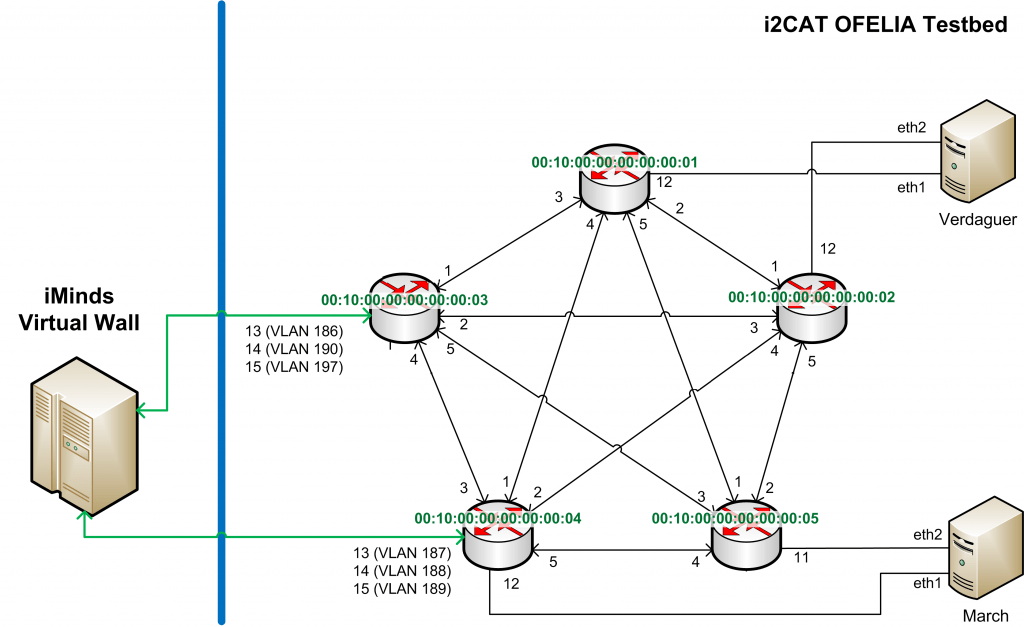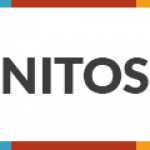What is the i2CAT OFELIA testbed?
The i2CAT OFELIA island provides an open facility to test and validate experimental research aligned with Future Internet technologies, specifically Software-Defined Networking (SDN) and virtualization. The infrastructure is virtualized in order to offer logical isolated substrates to enable simultaneous disruptive research experiments in productive environments without interfering with parallel research users; following an IaaS (Infrastructure as a Service) mode.
OFELIA i2CAT offers the following resources:
- 5x OpenFlow packet switches (NEC IP8800) where experimenters are allocated control of a set of VLANs on selected ports.
- 2x virtualization servers to act as source and since of traffic. Experimenters can deploy Debian 6 virtual machines on these servers. Access to the virtual machines is via SSH.
The OFELIA i2CAT testbed is connected via a dedicated experiment L2 link which allows experimenters to conduct inter-island experiments. Furthermore, the testbed is connected via dedicated experiment L2 link to Virtual Wall 2 testbed at iMinds/imec. OFELIA testbed is open to all experimenters who want to perform experiments on network behaviour control.

Architecture
Each of the three virtualization servers (Verdaguer and March) has 2 Ethernet interfaces linked to 2 of the 5 OpenFlow-enabled switches. The switches are linked forming a full mesh topology so experimenters can define their own virtual topology and control it. Apart from this, 2 of the switches are linked to iMinds VirtualWall testbed through 3 different ports each (ports 13, 14 and 15 of switches 00:10:00:00:00:00:00:03 and 00:10:00:00:00:00:00:04).
The OpenFlow-enabled switches allow defining and controlling virtual topologies over the physical servers, isolating the experiment traffic from other experiments. The virtualization servers allow configuring and deploying virtual machines for the experiments. On these virtual machines, the experimenter can install the software that controls the switches behaviour for the experiment traffic, e.g. sending specific packets to specific ports.
Experimentation
For conducting experiments, users request – through Fed4FIRE tools like OMNI or jFed – a network slice consisting of the following:
- Resources
- Virtual machines as end-hosts deployed on physical servers
- A virtual machine to deploy their OpenFlow-capable network controller/application
- Parts of the OpenFlow switches that connect to the user’s OpenFlow controller (a subset of the overall flowspace)
- Control
- Control of the flowspace defined with the above resources
The flowspace is defined by one or more VLANS. For each packet tagged with the VLAN of the experiment that has no rule defined in the flowtable of the switch, the switch will request the defined controller for a rule. This way, the experimenter can control the network behaviour. Also, users can install whatever software they want in the provided virtual machines.
Experiment examples
Example of an experiment performed over OFELIA testbed:
- Support for small-sized nodes connected via programmable networks:
- Small-sized nodes (e.g. those used for IoT) can be deployed as small virtual machines
- An SDN overlay can steer traffic from servers storing data and gateways to/from the IoT nodes
- OFELIA allows
- Instantiating multiple nodes in different servers connected via L2
- Defining SDN overlays to interconnect the deployed nodes
Contact
For any doubt, info or issue about i2CAT OFELIA testbed in Fed4FIRE you can contact: Carolina Fernandez carolina.fernandez@i2cat.net
More details on the testbed can be found here: http://lab.i2cat.net/testbed-openflow-wired/
Terms & conditions and data usage policy can be found in https://f4f.lab.i2cat.net/privacy/ and http://lab.i2cat.net/data-protection/.





